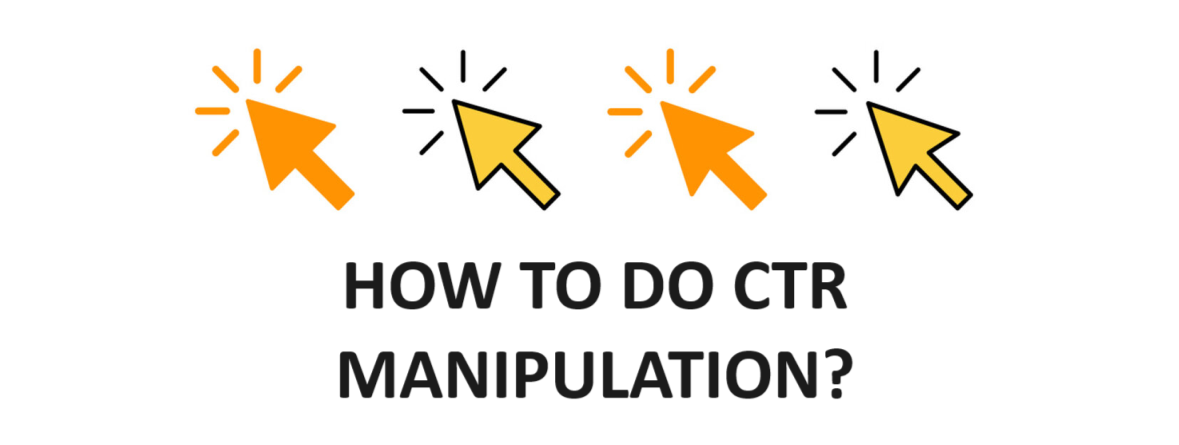Effective CTR Manipulation: Boost Your Click-Through Fees and Presence
Effective CTR Manipulation: Boost Your Click-Through Fees and Presence
Blog Article
Checking Out the Connection In Between CTR Adjustment Services and Customer Habits
In the realm of digital marketing, the influence of click-through price (CTR) adjustment solutions on user actions continues to be a facility and fascinating topic. By studying the detailed partnership between CTR manipulation solutions and customer behavior, fascinating understandings arise that may reshape our understanding of electronic advertising and marketing strategies and their results on customers.
Influence of CTR Manipulation on Behavior
Analyzing the impact of Click-Through Price (CTR) manipulation on customer behavior discloses critical insights right into the characteristics of online interaction. CTR manipulation includes artificially pumping up the number of clicks on a particular web link or promotion to deceive users and search engines. This method can bring about a distorted assumption of a webpage's popularity or significance, eventually influencing individual actions.

Additionally, CTR control can skew the data made use of by formulas to individualize user experiences. This can result in users being offered web content that does not straighten with their choices or passions, eventually causing a decline in customer complete satisfaction and involvement. Comprehending the effect of CTR manipulation on individual behavior is necessary for maintaining transparency and count on on the internet communications.
User Engagement With Controlled CTR
Customer involvement with controlled CTR information typically leads to manipulated perceptions of on the internet web content appeal and significance. When users connect with material based on artificially filled with air Click-Through Rates (CTR), they might believe that particular details, products, or services are much more preferred or credible than they really are. This can cause individuals choosing based on misleading information, bring about potentially undesirable outcomes.
Interaction metrics like likes, shares, remarks, and time invested in a webpage are typically affected by CTR control. Users might be much more inclined to involve with material that appears to have higher involvement prices, further continuing the cycle of skewed perceptions. As a result, web content developers and advertisers may prioritize creating content that produces high CTR instead than focusing on producing truly important and pertinent material.

Psychological Results of CTR Manipulation

Furthermore, the mental impacts of CTR control can also manifest in transformed decision-making procedures. Individuals may be a lot more likely to click material entirely based upon its regarded appeal, instead than its actual worth or relevance to their requirements. This behavioral change can lead to a superficial engagement with online content, where customers may forget premium i was reading this however less popular offerings in favor of those with unnaturally improved CTRs.
In essence, the psychological implications of CTR adjustment highlight the value of maintaining transparency and credibility in on-line interactions to foster genuine customer engagement and trust.
Moral Considerations in CTR Adjustment
Thinking about the moral implications of adjusting click-through rates (CTR) in on the internet systems is imperative for preserving honesty and count on within the electronic ecosystem. CTR control raises issues concerning deceiving individuals, misshaping information analytics, and compromising the credibility of on the internet web content. One significant ethical consideration is the possible influence on user autonomy and decision-making. By unnaturally blowing up CTR, users may be misinformed right into clicking on links or ads they would certainly not have actually picked otherwise, resulting in an insincere online experience. CTR manipulation can skew the efficiency metrics that companies count on to make calculated choices, inevitably influencing more information market competition and customer trust fund.
An additional honest element to consider is the fairness of manipulating CTR to obtain an unreasonable benefit over competitors. Taking part in such techniques not just breaches principles of justice yet likewise undermines the count on that users position in on the internet systems. It is important for businesses and electronic marketers to promote moral requirements in their practices to make sure transparency, reliability, and lasting sustainability in the on the internet environment.
Effects for Digital Advertising
With the enhancing reliance on electronic platforms for advertising and marketing functions, the practice of adjusting click-through rates (CTR) postures considerable implications for the performance and stability of digital marketing methods. CTR manipulation can bring about skewed information analytics, misdirecting marketing experts right into believing that their projects are carrying out better than they in fact are. This can result in misallocation of sources, with business buying underperforming techniques based upon falsified CTRs. In addition, when individuals realize that CTRs have actually been adjusted, it can wear down count on the brand name, bring about long-term unfavorable consequences for client commitment and brand name credibility.
Furthermore, using CTR control solutions can produce an unjust competitive landscape, where companies that engage in such practices gain an artificial benefit over those that comply with moral advertising and marketing criteria. This can stifle development and imagination in digital marketing, as success comes to be even more concerning control methods than supplying authentic value to consumers. Inevitably, the ramifications of CTR control for digital advertising and marketing expand past short-term gains, impacting the total sustainability and reliability of marketing initiatives in the electronic realm.
Conclusion
To conclude, the connection between CTR adjustment services and user actions is complicated and complex. The effect of why not try this out CTR manipulation on actions, individual engagement with adjusted CTR, mental effects, moral considerations, and effects for digital advertising and marketing all contribute in shaping this connection. Comprehending these characteristics is vital for marketing professionals and researchers alike in order to browse the ethical implications and make the most of the performance of their digital marketing methods.
Report this page